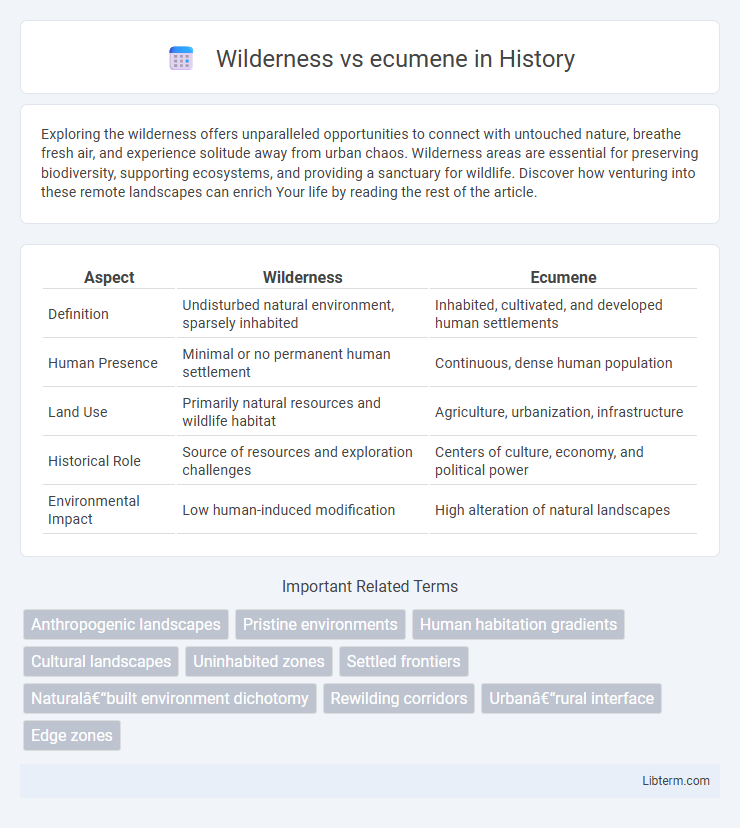Exploring the wilderness offers unparalleled opportunities to connect with untouched nature, breathe fresh air, and experience solitude away from urban chaos. Wilderness areas are essential for preserving biodiversity, supporting ecosystems, and providing a sanctuary for wildlife. Discover how venturing into these remote landscapes can enrich Your life by reading the rest of the article.
Table of Comparison
| Aspect | Wilderness | Ecumene |
|---|---|---|
| Definition | Undisturbed natural environment, sparsely inhabited | Inhabited, cultivated, and developed human settlements |
| Human Presence | Minimal or no permanent human settlement | Continuous, dense human population |
| Land Use | Primarily natural resources and wildlife habitat | Agriculture, urbanization, infrastructure |
| Historical Role | Source of resources and exploration challenges | Centers of culture, economy, and political power |
| Environmental Impact | Low human-induced modification | High alteration of natural landscapes |
Defining Wilderness and Ecumene
Wilderness refers to natural environments largely untouched by human activity, characterized by ecosystems that maintain their native flora and fauna without significant human alteration. Ecumene defines areas of permanent human settlement where landscapes have been extensively modified to support agriculture, urban development, and infrastructure. The contrast between wilderness and ecumene emphasizes the degree of human influence and habitat transformation, with wilderness representing ecological preservation and ecumene representing human-dominated landscapes.
Historical Perspectives on Human Settlement
Historical perspectives on human settlement reveal a dynamic contrast between wilderness and ecumene, where wilderness represents untamed, sparsely inhabited landscapes, while ecumene denotes regions with concentrated human activity and cultural development. Ancient civilizations often settled ecumene areas due to fertile soil, water availability, and strategic locations, transforming these spaces through agriculture, urbanization, and infrastructure. The transition from wilderness to ecumene reflects humanity's progressive domestication of the environment, driven by population growth, technological advancement, and socio-political organization.
Geographic Distribution of Wilderness vs Ecumene
Wilderness areas are predominantly found in remote, sparsely populated regions such as tundras, deserts, and dense forests, minimizing human impact and maintaining natural ecosystems. In contrast, ecumene represents the portion of Earth's surface characterized by permanent human settlements, including cities, towns, and agricultural zones, often concentrated in temperate and fertile areas. The geographic distribution of wilderness and ecumene reflects the balance between human habitation and natural landscapes, with wilderness shrinking as ecumene expands due to urbanization and land development.
Ecological Importance of Wilderness Areas
Wilderness areas play a crucial ecological role by serving as habitats for diverse species, maintaining genetic biodiversity, and supporting essential ecosystem processes such as water purification and carbon sequestration. Unlike ecumene, which represents regions of permanent human settlement and altered landscapes, wilderness remains largely unaffected by human activity, preserving natural ecological functions and resilience. Protecting these untouched environments is vital for sustaining global biodiversity and mitigating climate change impacts.
Human Adaptation in Ecumene Regions
Human adaptation in ecumene regions involves the development of advanced agricultural techniques, urban infrastructure, and cultural innovations to sustainably inhabit areas with favorable climates and resources. These adaptations include domestication of plants and animals, construction of permanent settlements, and technological advancements that enhance food production and shelter. Unlike wilderness areas, ecumene regions reflect significant human modification of the natural environment to support growing populations and complex societies.
Socioeconomic Impacts of Development
The development of ecumene areas leads to expanded economic activities, including agriculture, industry, and commerce, which significantly enhance regional GDP and employment rates. Conversely, wilderness preservation supports ecosystem services that provide long-term socioeconomic benefits, such as water purification, carbon sequestration, and tourism revenue, which are often undervalued in modern development models. Balancing wilderness conservation with ecumene expansion is critical for sustainable economic growth and social well-being, as unchecked development can degrade natural resources essential for human livelihoods.
Conservation Challenges in Transitional Zones
Transitional zones between wilderness and ecumene face significant conservation challenges due to habitat fragmentation, increased human-wildlife conflicts, and the spread of invasive species. These areas require targeted management strategies that balance ecological preservation with sustainable human development to maintain biodiversity and ecosystem services. Effective conservation efforts must integrate spatial planning, community engagement, and adaptive monitoring to address the dynamic pressures in these ecotones.
Role of Technology in Shaping Ecumene
Technology drives the expansion and transformation of the ecumene by enabling human adaptation to previously inhospitable environments. Innovations in agriculture, transportation, and communication reduce the boundary between wilderness and settled areas, facilitating urban growth and resource exploitation. Advanced technologies such as GIS and remote sensing optimize land use planning, further integrating wilderness into the human-dominated ecumene.
Policy Approaches to Wilderness Preservation
Wilderness preservation policies prioritize limiting human impact through strict land-use regulations and establishing protected areas managed by agencies like the U.S. Forest Service and National Park Service. Ecumene-focused approaches emphasize sustainable development and resource use to balance human habitation with environmental conservation, often incorporating indigenous knowledge and community-based management. Effective wilderness policy integrates scientific research, habitat restoration, and stakeholder collaboration to maintain biodiversity and ecological integrity while addressing challenges from climate change and increasing land use pressures.
The Future Balance: Sustainable Coexistence
The future balance between wilderness and ecumene hinges on sustainable coexistence that respects biodiversity while supporting human development. Integrating conservation corridors, urban green spaces, and smart land-use planning can mitigate habitat fragmentation and promote ecosystem services. Emphasizing renewable energy, community-based stewardship, and adaptive management ensures both ecological integrity and socio-economic resilience thrive together.
Wilderness Infographic

 libterm.com
libterm.com